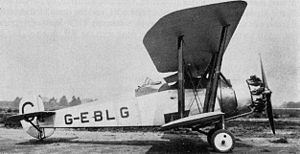Top speed 217 km/h Length 9.6 m | Wingspan 14 m First flight June 8, 1925 | |
 | ||
The Bristol Boarhound was a British army cooperation and liaison aircraft of the 1920s. It was a two-seat biplane with wings of equal span, of steel frame construction with fabric covering.
Contents
Design and development
The Boarhound was built as a private venture to Air Ministry Specification 8/24 (later superseded by Specification 20/25) for an Army cooperation aircraft to replace the Bristol Fighter, first flying on 8 June 1925 as the Type 93 Boarhound.
The Boarhound, designed by Captain Frank Barnwell, was a two-bay biplane which used a method of steel construction which involved high-tensile steel strips, rolled into cusped and flanged sections, which were riveted together to form longerons and struts. The resulting structure was lighter, stronger and cheaper than one made from drawn tubes. It had a deep fuselage allowing bulky radio and camera equipment to be carried, and was powered by a Bristol Jupiter IV engine with variable timing.
The Boarhound was evaluated alongside the Armstrong Whitworth Atlas, de Havilland Hyena and Vickers Vespa. The Jupiter's variable timing gear gave poorer power at low altitudes, a disadavantage for an army cooperation aircraft, and the Atlas was considered superior.
The Directors of Bristol decided, however, to continue development of the aircraft as a private venture for a general-purpose bomber to replace the Airco DH.9A. A second aircraft was therefore built, the Type 93A Beaver, flying on 23 February 1927. This was rejected in favour of the Fairey IIIF, which used the preferred Napier Lion engine, of which large numbers were in store.
The Boarhound I (registered G-EBLG) and the Beaver (registered G-EBQF) were withdrawn from use at Filton Aerodrome in April 1927.
A further two aircraft were produced as reconnaissance fighters as the Type 93B Boarhound II.
Operational history
The only two Boarhound IIs ever built were sold to Mexico in 1928, and were used against rebel forces in April 1929. The Boarhounds proved successful in Mexican service, their metal structure proving suitable for the climate. Two legends of the Mexican Air Force flew the Boarhound II: Pablo Sidar and Alfonso Cruz Rivera.
Variants
Operators
Specifications (Boarhound I)
Data from Bristol Aircraft Since 1910
General characteristics
Performance
Armament
